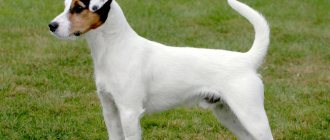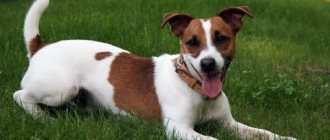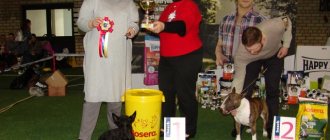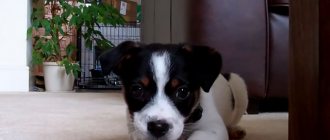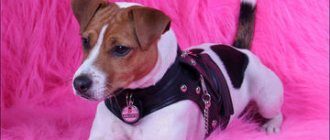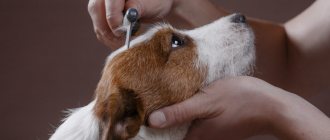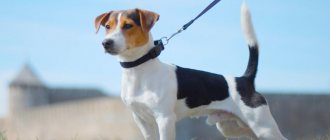The Parson Russell Terrier is one of the Russell group breeds. In Russia, another breed is better known - the Jack Russell Terrier, the short-legged brother of the Parson, but in Europe, on the contrary, the Parson Russell is more popular. Both dog breeds originated from the same roots, as will be discussed below.
Purebred Parson Russell Terriers are valued by game hunters for their ability to run for a long time and tirelessly. City dwellers see in them other distinctive qualities: tirelessness, speed and fearlessness.
Brief history of origin
The Jack Parson Terrier got its name in honor of the British pastor (from the English parson) Jack Russell. The priest was a lover of hunting, but his main passion was breeding dogs. Therefore, he created a completely new unique hunting breed.
By crossing the Fox Terrier with fighting dogs and other breeds and long-term selection work, the Parson Jack Russell Terrier was born, a long-legged burrowing dog that tirelessly runs after the horse.
Work on crossing Burrow Terriers continued even after the death of the priest-hunter. And for some time, two types of Russells existed in parallel - long-legged and short-legged.
The division into two different terrier breeds occurred in 1990. In Great Britain, a temporary standard was created confirming the existence of the Parson Russell Terrier breed. Six months later, the International Canine Federation (ICF, or FCI) recognized the Jack Parson.
The dog received its current name in 1999, thanks to the British Kennel Society. And in 2001, the FCI officially created two breed standards for Russell Terriers:
- Jack Russell;
- Parson-Russell.
And although Pastor Jack was not successful in church affairs, he left two unique breeds of terriers for the world.
Upbringing
Puppies strive to dominate from an early age, so it is necessary not to miss the right moment and stop trying. As soon as the baby appears on the doorstep of the house, it is necessary to teach him what is allowed to do and what is not allowed in his behavior. Especially the dog should know its place and not try to use affection and amusement to occupy the owner’s bed. Attacks, begging, and other attempts must be immediately and firmly prohibited. Parson loves to test his owner's strength and authority: having noticed compliance, he will immediately take the leading position. When traveling by car, you should not seat your dog in the front so that it does not feel its equal rights.
During walks, a representative of the breed will try to dig a flower bed, so from the first walks it is necessary to accustom the animal to etiquette; as well as from the habit of barking at other, especially large dogs - this will protect both the health and life of the terrier.
Interesting Facts
- July 2 is Parson Russell Terrier Day. It was on July 2, 1999 that the IFF officially recognized the breed. Dog lovers and owners get together, hold competitions or simply celebrate together.
- Parson Terriers are the best high jumpers. The current breed record is a jump of 198 cm.
- Jack Russell was not only a lover of hunting, but also of horse riding. Therefore, another criterion for the new breed was the ability to quickly and tirelessly run after a horse. This breed is named among the top ten dogs that are the best long-distance running partners.
Training
Russells are trained depending on the purpose for which they purchased the dog. A hunting dog is raised by one set of rules, a companion by another. Hunting skills are best developed by specialists in canine organizations. This is a rather difficult process that develops in the dog courage, perseverance, and the ability to make decisions. A domestic Russell is a completely different matter. They are quite obedient, but it is forbidden to tease the dog, and you cannot use methods such as beating and screaming in training. It is best to use the incentive method.
For more information about the characteristics of this breed, see the following video.
Breed description, standards and appearance
The Parson is slightly taller and larger than his Jack Russell cousin due to the length of his legs. At the withers, dogs reach 33–36 cm; the normal weight of Parsons is 6–8 kg.
The description of the Parson Russell Terrier breed is given in the ICF standard No. 339: group 3 - terriers, section 1 - large and medium terriers.
- The head is moderately wide with a smooth stop and occipital protuberance, and bright brow ridges.
- The muzzle has a straight line across the bridge of the nose, tapering towards the nose but not becoming pointed. The teeth are closed in a scissor bite. The jaws are strong.
- The ears are semi-erect, medium in size, set high. The shape of the ears is a pointed triangle.
- The eyes of dogs of this breed are medium-sized, almond-shaped, and set close together. The iris is always dark.
- The nose is small and dark.
- The body is square, muscular and fit. The top line is straight with a convex croup and withers. The stomach is tucked in, the chest is moderately lowered to the middle of the elbow. The neck is of medium length.
- The tail is a continuation of the croup, uneven, of medium length.
- The limbs are long, straight, strong. The movements are wide.
Color and coat type
The description of the breed considers three types of coat:
- smooth-haired Parson Russell Terrier,
- wirehaired,
- brocken (intermediate).
The base color is considered to be white; red, yellow, black and red large spots are allowed. Many Jack Parsons have a different head color than their body.
Parson Russell Terriers are in heat
- age of onset of the first estrus in a female dog is 6-12 months;
- duration of estrus is 20-22 days, sometimes up to a month;
- frequency of estrus – 1-2 times a year with an interval of 6-9 months;
- signs of estrus – swelling of the dog’s external genitalia, spotting;
- frequent urination - having to walk more often than usual;
- psychological signs - a change in the dog’s behavior - from aggressive to lethargic;
- perhaps there is a change in appetite and the dog drinks more water;
- often bitches begin to shed before going into heat;
- lick the loop intensively.
You can notice the approach of estrus while walking your dog. Behavior can change, often the dog becomes active, playful and disobedient, or, on the contrary, looks unhappy and lethargic. The bitch makes frequent marks - scent “lures” for male dogs, and urination occurs more frequently. The loop becomes more and more swollen; when pressed, you can see a discharge of light pink or dull pink color. If you notice changes in the dog's behavior, do not be lazy and check the dog every day for the onset of heat by dabbing the bitch's loop with a napkin or toilet paper. Pinkish discharge will be the beginning of estrus - mark this day in your dog’s notebook.
The course of the dog's first heat.
- The first heat in dogs is not the same as the next one.
- It may be shorter or longer than the usual estrus period.
- The bitch has either only weak manifestations of estrus, or, conversely, very heavy discharge.
- The first heat may suddenly stop, and then after some time begin again.
- There may be mucous discharge from the loop, a smell that attracts males, and the estrus itself will begin after some time.
- Try not to miss the start time of the first, and subsequently the second estrus, in order to correctly determine the intervals between estrus and know their timing and duration.
Precautions during estrus. If you are not interested in getting puppies from a dog, you need to take precautions during heat:
If you are not interested in getting puppies from a dog, you need to take precautions during heat:
- walk your dog ONLY on a leash: even the most obedient dog these days can simply run away, not paying attention to commands;
- do not allow male dogs to mount the dog: if sexual intercourse begins, it is almost impossible to separate them;
- during a walk, literally DO NOT take your eyes off the dog, even when buying bread in a tent, eliminate or minimize contact with male dogs;
- there is a danger of the dog catching a cold in the cold season, the best way to protect yourself is not to walk for a very long time in cold weather and use dog clothes;
- If your dog lives freely on your territory, then from the moment the estrus begins, lock the dog in an enclosure.
Character and behavior
This dog is a real egoist. The Jack Russell considers himself the center of the universe, he needs all the attention of his owner, all his free time. Russell does not like to share his owner with other people, so he can snap or get angry. But if Jack Parson grew up with a child, in a big house full of people, then he will give his love to every member of the household.
In general, the description of the Parson Terrier's character is positive. The animals are active, cheerful, and not aggressive.
They have developed mental abilities, good hunting and security instincts. But the breed is not suitable for an inexperienced owner.
A person unfamiliar with the basics of training will not be able to raise a dog and rid it of negative traits: rancor, resentment, waywardness.
List of suitable nicknames
When choosing names for dogs that are dexterous, smart and have an attractive appearance, owners are guided by different motives. The impetus can be the behavior of the animal, its playful nature, or even the owner’s commitment to a certain literary genre.
In any case, the nickname should not be long. Preference is given to easily pronounced sonorous words.
Options for boys:
- Arnie, Barney, Bruno, Jack, Willie, Vinci;
- Gail, Devin, Jacqui, Cliff, Leon, Marty, Miguel;
- Neil, Nick, Olive, Austin, Rex, Rich, Ronnie;
- Toby, Fidel, Charlie, Edwin, Ernie, Standard.
Examples for girls:
- Aidi, Alma, Bessie, Dana, Daisy, Jessie, Jeta;
- Jasmine, Julia, Cameo, Casey, Katie;
- Lara, Lisa, Lolita, Lulu, Malva, Molly, Mary;
- Notka, Nicole, Olivia, Sally, Selena, Snezhka, Sofia;
- Flo, Fortuna, Eureka, Justi.
How to choose the right puppy
Parson Russell Terrier puppies are practically no different from Jack Russell babies. Small dogs are identical until 9–12 months, when the difference in size and build becomes noticeable. Because of this similarity, inexperienced dog breeders purchase crossbreeds, and scammers easily pass off one breed as another.
Some prefer to take teenagers (6-7 months) in order to see external qualities, advantages and disadvantages, because by this age babies acquire the features of adult dogs.
In order not to make a mistake with your purchase, you need to contact the official breed nursery.
Unfortunately, in Russia there are few breeders involved in breeding Parsons; Jack Russells are more popular.
Important! All kids should be clean, active and healthy. Passivity, lack of reaction to a stranger is a pathological sign.
Breeding
When purchasing a parson, you should immediately decide whether the animal will be used for reproduction. If this is not planned, then it is recommended to castrate the dog and sterilize the female. Such measures will allow them to maintain a balanced character.
When deciding to start breeding on your own, take into account that reproductive maturation of Parsons occurs at 1 year. It is advisable to carry out the first mating at the age of two during the period of estrus, which lasts on average 2 weeks.
A female can bear up to 8 puppies, but the birth of 4 to 6 babies is considered normal. Pregnancy lasts 56-72 days. After a month, the belly is already enlarging, the mammary glands are noticeably swollen.
A secluded place with soft bedding is prepared for whelping. Be sure to notify the veterinarian, who can quickly provide assistance if complications arise.
Caring for puppies
A newborn puppy must live with its mother and feed on her milk. Upon reaching one month, little Jack Parsons begin to be fed: cow's milk, milk porridge. A competent breeder introduces new products into the diet carefully and, upon transfer, will inform the new owner of all the necessary details.
After two months, fermented milk products and finely chopped meat are added to the diet. After three months, they include porridge (buckwheat, rice), the yolk of a hard-boiled egg, vegetables and fruits.
Important! All products are introduced into the diet gradually: after adding a new dish, leave for at least a day, observing the dog’s body.
Babies are fed 6 times a day, gradually reducing to 3 times by six months. By the age of one year, Jack Parson Terriers are transferred to two feedings a day: morning and evening, serving size is 200–250 g.
Important! It is better to take care of Russell Terrier babies to avoid stress on the immature skeleton. Puppies are walked 3-4 times for 30 minutes, they are not allowed to jump or go down stairs a lot.
Feeding the animal
It is desirable that the pet’s diet consist of natural food in the ratio: 50% meat products and 50% plant products .
It is necessary to completely exclude fish and its waste, sour and spicy foods. Once every two weeks, to maintain immunity, it is recommended to give the Parson Russell dairy products: cottage cheese, low-fat sour cream, cheese, you can give boiled eggs.
Meat nutrition can consist of homemade lean pork, beef, chicken, rabbit . It is allowed to add meat by-products to the diet, but it is important to understand that they cannot completely replace meat.
Vegetables can be given either raw or cooked..
Russell Terriers happily gobble up carrots, zucchini, tomatoes, pumpkin, cabbage, and beets. They can also eat onions, but it is better not to give it to them, as problems with the digestive tract may arise.
Care and maintenance
You can keep a Jack Parson Terrier both at home, indoors, and in the local area - in a kennel.
The dog will not adapt to a chain or enclosure; the best option for a Jack Parson is the ability to go out into the yard at any time. But even in city apartments, dogs get along well.
Parson Russell Terriers are unpretentious in food and care. Such pets don’t need much; for them, heaven is in a hut if there is an owner nearby. Well, the owner must take care that the pet is healthy and cheerful.
The right diet
The choice between dry ready-made food and natural food is up to the owner of any dog, and the owner of the Parson Russell Terrier will also have to decide for himself. There are pros and cons to any type of nutrition.
Representatives of the breed do not suffer from allergic reactions, but it is better to make a choice in favor of expensive super-premium food, which does not contain dyes, preservatives, starch and wheat. The granules should be medium in size. Calorie content is medium or high - for active dogs.
Natural food is always healthier than dry food, but it requires time. The owner will have to independently select and prepare food and prepare a diet.
Meat (chicken, lean beef, lamb) is not boiled, but doused with boiling water.
Cereals (oatmeal, buckwheat, rice) are boiled in water - broths do not benefit dogs. Fruits and vegetables (apples, carrots, beets) are boiled along with porridge or given raw. You can supplement the protein part of the Jack Russell's diet with kefir, cottage cheese, and sea fish.
Important! Despite their strong stomachs, Parson Russell Terriers cannot digest bones.
It is also forbidden to give Jack Parsons pork, sugar, flour products, legumes, potatoes, strong allergens (nuts, tomatoes, garlic and onions, milk).
Walking and physical activity
Parson Russell Terriers are very active dogs with an endless supply of strength and energy. They never get tired and can run, hunt, and train for a long time.
Being locked up is real torture for them.
Walk Russells 2-3 times a day for 1.5-2 hours. It’s better if walks turn into a fun game, jogging, talking with dogs in the park.
Jack Parson will never give up traveling and will support any of his owner’s ventures: water rowing, cycling, rollerblading, karting, mountain tourism.
Training and education
The main thing in training is socialization. From an early age, a pet must communicate with unfamiliar people and animals, then he will learn to control outbursts of emotions and restrain anger.
The intelligence of Jack Parson Terriers is well developed. They quickly grasp new things, remember commands, and understand people. Lack of interest and excessive activity become a barrier to learning. Therefore, owners are recommended to alternate mental stress with physical activity.
Important! Jack Parsons remain hunting dogs, working on foxes, badgers and small rodents. To “train” your pet, you can send it to a dog training school or to a professional hunter.
Parson Russell needs to learn all the basic commands: “sit”, “lie down”, “place”, “near”, “no”, “voice”. It is difficult to control a dog that does not know basic commands. When they are learned, you can move on to additional ones: “somersault”, “serve”.
To develop intellectual abilities, Jack Parsons are trained to respond to light or sound signals, claps, and hand movements.
Care and hygiene
Hair care depends on its type. Dogs with short hair do shed, but do not need to be bathed or brushed frequently. Wire-haired terriers do not lose hair, but they require timely trimming - plucking the hair (3-4 times a year).
Usually dogs are bathed 2 times a month or when heavily soiled, but wool debris is removed daily and paws are washed after each walk.
Parson Terriers have their nails trimmed once every 2 months if the plates do not wear off on the asphalt.
Important! Parsons have semi-erect ears, so inflammation often occurs. You should inspect the sinks daily for the presence of wax or unusual discharge and clean them with a cotton pad soaked in lotion.
Mating
Mature and fully formed animals that are 1.5-2 years old are allowed for mating. Before this, it is advisable to introduce them, otherwise the bitch may show aggression when the male tries to mount.
Breeders more often practice hand-breeding Parson Terriers when the pets are on leashes under the control of the owners. For beginners, it is better to invite a professional instructor.
Pregnancy lasts about 60 days. The first signs appear late - only after the first month. All this time, the bitch is protected from stress, drafts and provided with adequate nutrition.
Childbirth is easy because Parsons have normal body proportions. Veterinarian assistance is usually not required. But the owner should arrange a visit with the doctor in advance in case of sudden complications. Most often 4-6 puppies are born in a litter.
Vaccinations and susceptibility to disease
Vaccination is the only method of preventing dangerous viral diseases that the dog’s immune system is not able to cope with. Vaccination begins early, at 2.5 months. Then the puppy is injected with strains of distemper, enteritis, hepatitis, and parainfluenza. After 2-3 weeks, the vaccination is repeated, adding leptospirosis.
At 6–7 months they are vaccinated against rabies. All vaccinations are repeated annually to prolong the effect of the drug.
The Parson Russell Terrier breed is considered one of the healthiest dogs in the world. She does not have heart or gastrointestinal problems or neurological spectrum disorders. But dogs are not without genetic diseases.
The main problem is necrosis of the femoral head. It appears by the age of 5–6 years. The common name of the disease is Legg-Peters disease.
Congenital deafness is less common. It is typical for individuals with a pure white coat color.
Important! A congenital disease that can be seen in puppies is a lack of coordination of movements. It is incurable and is characterized by disorientation in space and chaotic movements.
Reviews
The opinion of the owners of such dogs is of interest.
Oleg, Vladimir: “A year ago I adopted a wire-haired Parson Russell. I'm just delighted with it. We run with him in the mornings and also walk in the evenings. I noticed that my shortness of breath disappeared and my muscles became stronger.”
Anna, Gryazovets: “The children were the initiators of purchasing the puppy. It took us a long time to choose a breed. We settled on parson and did not regret it. This dog is a great friend and ally. Plays with children, accompanies adults. At home requires attention. Capable of making a mess alone.”
Oksana, Astrakhan: “My pet recently turned 5 months old. I can say that with his appearance we became noisy and incredibly fun. Our little parson takes part in all children's activities and loves to run, so walks are dynamic. He is raised by his husband. We have already mastered the basic commands, since the pet is smart, although it can be cunning if it is too lazy to repeat the exercises.”
Pros and cons of the breed
Parson Russell Terriers require a lot of attention; they are not suitable for busy businessmen, families with very young children, or elderly people.
Jack Parsons are constantly on the move and love jogging and walking. This breed is an excellent option for athletic young people with a lot of free time.
| pros | Minuses |
| Adaptability to any conditions | Naughtiness, mischief |
| Activity, cheerfulness | Uncontrollable emotions, anger |
| Developed hunting instincts | Need for serious education |
| Relentless in training and games | The breed is rare, it is difficult to find a purebred representative |
| Easy to care for | |
| Lack of shedding (in wire-haired Parson Terriers) |
Raising a loyal Parson Russell Terrier friend is not a problem. The main thing is to give your all, to love the dog as a new member of the family, to accept all the shortcomings and advantages.
Parson subtly feels all human emotions and is not stingy to give everything in full: both love and hatred.
Socialization
Parson Russell puppies must be socialized at the earliest possible age. They must learn to treat the people around them calmly, feel confident in any environment and competently assess current events.
When raising a puppy, the owner should be patient, otherwise the Parson Russell will grow up to be an eccentric dog. Dogs are trained in a playful manner - they quickly get bored with monotonous activities. You cannot demand unquestioning obedience from an animal - this is not a service breed.
Inside the Parson Terrier lies a true hunter - this should not be forgotten. He perceives small pets as potential prey. Such behavior should be stopped immediately.
It is better for a novice dog breeder to give the puppy to a dog handler. This is a serious hunting dog, so it will be difficult for a non-professional to train it competently.
Parson Terriers often have conflicts with their relatives. The animals are quite cocky and can provoke fights with large dogs. If there is already a dog living in the house, it is better not to buy a puppy of this breed. Even proper socialization does not guarantee the absence of problems in the future.
Parson Russell only likes to play with teenagers who treat him with respect. It is better not to leave your pet alone with children. He may bite a child if he encroaches on his property - a sleeping place, bowl or toys.
